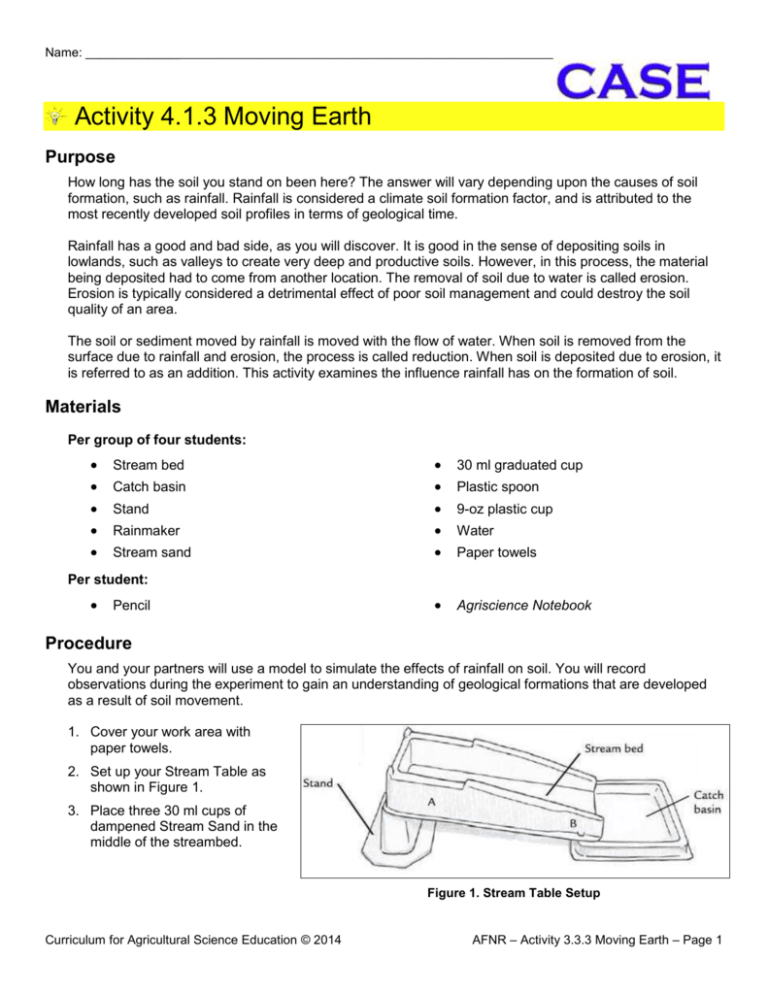Activity 3.3.3 Moving Earth
advertisement

Name: ___________________________________________________________________ Activity 4.1.3 Moving Earth Purpose How long has the soil you stand on been here? The answer will vary depending upon the causes of soil formation, such as rainfall. Rainfall is considered a climate soil formation factor, and is attributed to the most recently developed soil profiles in terms of geological time. Rainfall has a good and bad side, as you will discover. It is good in the sense of depositing soils in lowlands, such as valleys to create very deep and productive soils. However, in this process, the material being deposited had to come from another location. The removal of soil due to water is called erosion. Erosion is typically considered a detrimental effect of poor soil management and could destroy the soil quality of an area. The soil or sediment moved by rainfall is moved with the flow of water. When soil is removed from the surface due to rainfall and erosion, the process is called reduction. When soil is deposited due to erosion, it is referred to as an addition. This activity examines the influence rainfall has on the formation of soil. Materials Per group of four students: Stream bed Catch basin Stand Rainmaker Stream sand 30 ml graduated cup Agriscience Notebook Plastic spoon 9-oz plastic cup Water Paper towels Per student: Pencil Procedure You and your partners will use a model to simulate the effects of rainfall on soil. You will record observations during the experiment to gain an understanding of geological formations that are developed as a result of soil movement. 1. Cover your work area with paper towels. 2. Set up your Stream Table as shown in Figure 1. 3. Place three 30 ml cups of dampened Stream Sand in the middle of the streambed. Figure 1. Stream Table Setup Curriculum for Agricultural Science Education © 2014 AFNR – Activity 3.3.3 Moving Earth – Page 1 4. Use the spoon or your fingers to pack the sand into an even layer that covers the streambed from point A to point B. 5. Place the Rainmaker over point A as shown in Figure 2. 6. Add one 30 ml cup of water to the Rainmaker and observe. Use the space below to sketch the patterns produced by the water from Point A to Point B. Figure 2. Placing the Rainmaker Point A Point B 7. Add another 30 ml cup of water to the Rainmaker and observe. Use the space below to sketch the patterns produced by the water from Point A to Point B. Point A Point B 8. Add a third 30 ml cup of water to the Rainmaker and observe. Use the space below to sketch the patterns produced by the water from Point A to Point B. Point A Curriculum for Agricultural Science Education © 2014 Point B AFNR – Activity 3.3.3 Moving Earth – Page 2 9. Clean up your work area as instructed by your teacher. Conclusion 1. Describe the major changes that occurred each time 30 ml of rain fell on the streambed. 2. Where did the greatest amount of reduction occur? Based on your observations, explain why reduction takes place in this location. 3. Where did the greatest amount of addition occur? Based on your observations, explain why addition takes place in this location. 4. Explain why it is important for agriculturalists to understand and determine where additions and reductions of soil are occurring in today’s topography. 5. Explain why it is important to understand and determine where additions and reductions of soil have occurred in the past. Source: Lab-Aids Incorporated. (2001). Modeling stream erosion and deposition [Brochure]. Ronkonkoma, NY: Author. Curriculum for Agricultural Science Education © 2014 AFNR – Activity 3.3.3 Moving Earth – Page 3



